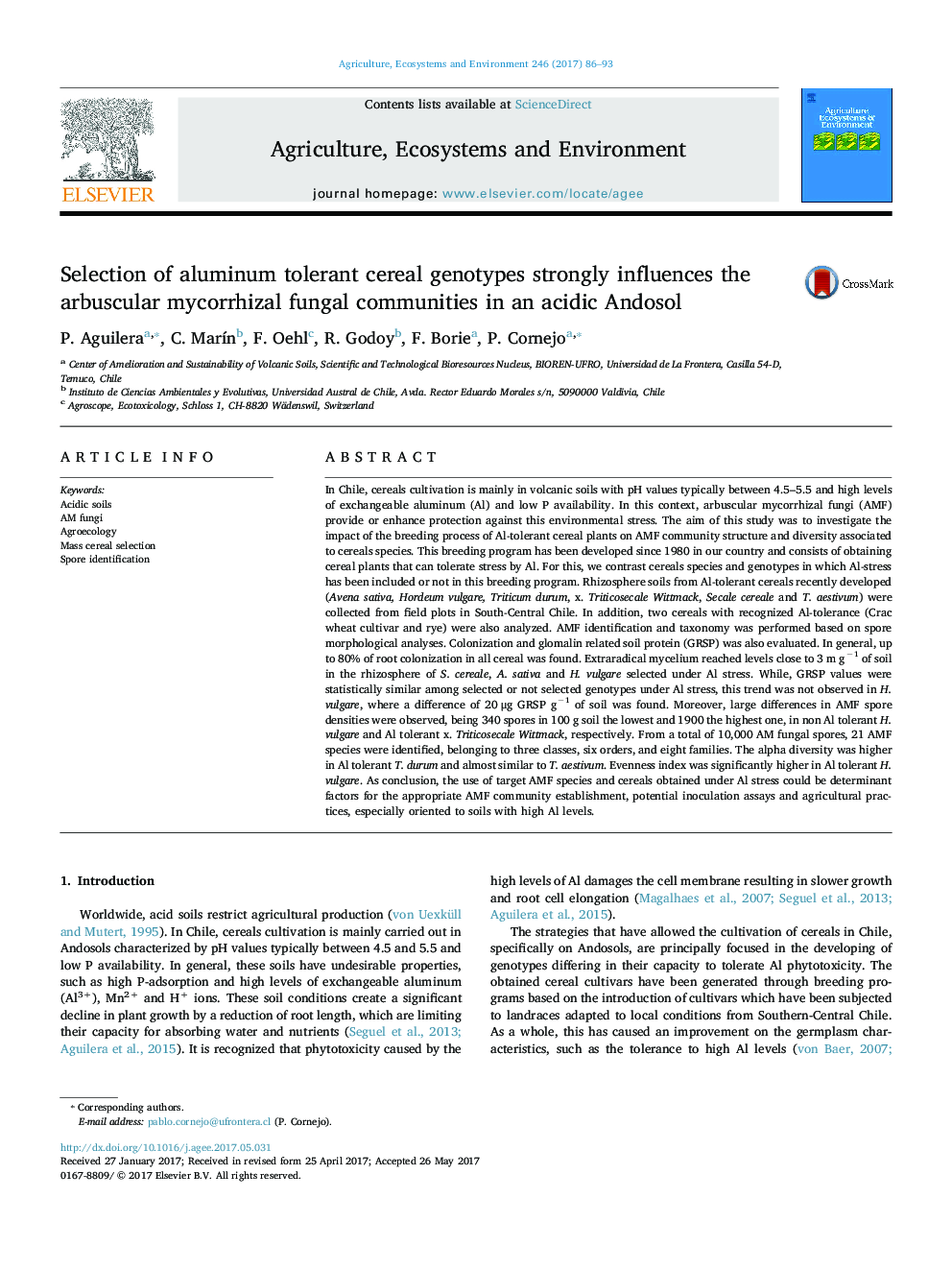| کد مقاله | کد نشریه | سال انتشار | مقاله انگلیسی | نسخه تمام متن |
|---|---|---|---|---|
| 5538031 | 1552006 | 2017 | 8 صفحه PDF | دانلود رایگان |
عنوان انگلیسی مقاله ISI
Selection of aluminum tolerant cereal genotypes strongly influences the arbuscular mycorrhizal fungal communities in an acidic Andosol
ترجمه فارسی عنوان
انتخاب ژنوتیپ های غلات مقاوم به آلومینیوم به شدت بر جوامع قارچی میربوریزه آربوسکولار در آندوسول اسیدی تاثیر می گذارد
دانلود مقاله + سفارش ترجمه
دانلود مقاله ISI انگلیسی
رایگان برای ایرانیان
موضوعات مرتبط
علوم زیستی و بیوفناوری
علوم کشاورزی و بیولوژیک
علوم زراعت و اصلاح نباتات
چکیده انگلیسی
In Chile, cereals cultivation is mainly in volcanic soils with pH values typically between 4.5-5.5 and high levels of exchangeable aluminum (Al) and low P availability. In this context, arbuscular mycorrhizal fungi (AMF) provide or enhance protection against this environmental stress. The aim of this study was to investigate the impact of the breeding process of Al-tolerant cereal plants on AMF community structure and diversity associated to cereals species. This breeding program has been developed since 1980 in our country and consists of obtaining cereal plants that can tolerate stress by Al. For this, we contrast cereals species and genotypes in which Al-stress has been included or not in this breeding program. Rhizosphere soils from Al-tolerant cereals recently developed (Avena sativa, Hordeum vulgare, Triticum durum, x. Triticosecale Wittmack, Secale cereale and T. aestivum) were collected from field plots in South-Central Chile. In addition, two cereals with recognized Al-tolerance (Crac wheat cultivar and rye) were also analyzed. AMF identification and taxonomy was performed based on spore morphological analyses. Colonization and glomalin related soil protein (GRSP) was also evaluated. In general, up to 80% of root colonization in all cereal was found. Extraradical mycelium reached levels close to 3 m gâ1 of soil in the rhizosphere of S. cereale, A. sativa and H. vulgare selected under Al stress. While, GRSP values were statistically similar among selected or not selected genotypes under Al stress, this trend was not observed in H. vulgare, where a difference of 20 μg GRSP gâ1 of soil was found. Moreover, large differences in AMF spore densities were observed, being 340 spores in 100 g soil the lowest and 1900 the highest one, in non Al tolerant H. vulgare and Al tolerant x. Triticosecale Wittmack, respectively. From a total of 10,000 AM fungal spores, 21 AMF species were identified, belonging to three classes, six orders, and eight families. The alpha diversity was higher in Al tolerant T. durum and almost similar to T. aestivum. Evenness index was significantly higher in Al tolerant H. vulgare. As conclusion, the use of target AMF species and cereals obtained under Al stress could be determinant factors for the appropriate AMF community establishment, potential inoculation assays and agricultural practices, especially oriented to soils with high Al levels.
ناشر
Database: Elsevier - ScienceDirect (ساینس دایرکت)
Journal: Agriculture, Ecosystems & Environment - Volume 246, 1 August 2017, Pages 86-93
Journal: Agriculture, Ecosystems & Environment - Volume 246, 1 August 2017, Pages 86-93
نویسندگان
P. Aguilera, C. MarÃn, F. Oehl, R. Godoy, F. Borie, P. Cornejo,
